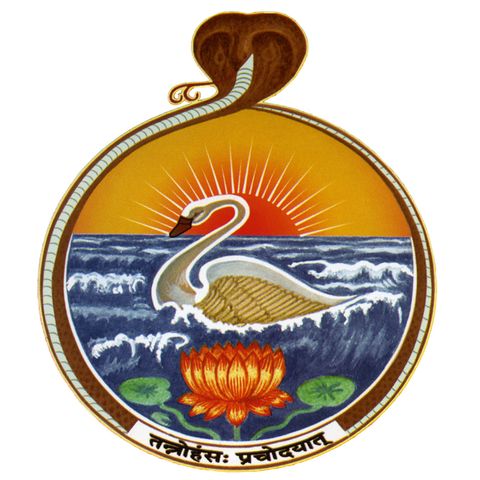Vivekachudamani 9 | Gross and Subtle Body | Swami Tattwamayananda

Jul 15, 2019 ·
1h 11m 13s
Verses: 82-96 This lecture was given by Swami Tattwamayananda at Stanford University on July 14, 2019. The lecture was hosted by the Stanford Hindu Students Association. -An elaborate analysis of...
show more
Verses: 82-96
This lecture was given by Swami Tattwamayananda at Stanford University on July 14, 2019. The lecture was hosted by the Stanford Hindu Students Association.
-An elaborate analysis of the non-self (anatman). Descriptions of sthula-sharira (gross body) and sukshma-sharira (subtle body) are provided.
-Comparisons to Buddhist interpretation of anatman. Concept of Sunyata in Buddhism is not nothingness – rather it refers to the indescribability of the Absolute Reality.
-Anatma is made of three parts: (1) Sthula-sharira (2) Sukshma-sharira and (3) Karana-sharira
82nd verse: if one wants liberation, one should reject all kinds of desires for material enjoyment, and stay away from them, as one would stay away from poison. Take to contentment, kindness, forgiveness, truth and peace.
A householder who does not strive for dharma, artha, kama through proper means is considered “adharmi”. Sri Ramakrishna and Hazra’s story is discussed. Hazra ignored his duty towards his mother, wife and children to pursue a spiritual life – he was scolded by Sri Ramakrishna for ignoring his duty as a householder.
Begin by desisting from doing what you are not supposed to do. Eventually, you will be able to do what you are supposed to do.
85th verse: Obsessive attachment to sensory pleasures without a spiritual ideal is “moha”. Moha conceals the reality and projects the wrong idea. Moha can lead to spiritual death. Only those who give up moha deserve mukti.
-87th verse: Gross body is detestable as it is composed of skin, flesh, blood, fat, marrow and bones. If we touched those things, we would wash our hands. However, the same gross body is a great asset, as it is what we use to achieve liberation. The journey beyond the body needs the body itself.
Kalidasa-Kumara-Sambhava story of Shiva and Uma is discussed. Shiva advises Uma to not ignore the gross body as she pursues austerities.
96th verse: Sukshma-Sharira has eight units: (1) Five organs of perception (2) Five organs of action (3) Five pranas (4) Five subtle elements (5) Antahkarna – mana, buddhi, chitta, ahamkara (6) Avidya (7) Kama and (8) Karma.
Sukshma-sharira defines one’s personality. Gandhi’s example is discussed as stark contrast between sthula and sukshma sharira.
Vritti is residual effect in mental system from any thought, deed or speech. Vritti => Samskara => Vasana => Karma form a continuous cycle.
Story of Vyadha Gita is discussed to illustrate path to liberation as a householder.
-Mahendra nath Gupta’s story is discussed – Sri Ramakrishna advises him to stay as a householder and pursue his spiritual journey. He had great respect for monks.
A householder needs to follow the path of dharma in his pursuit of artha and kama. This helps him understand the limitations of artha/kama and have a higher ideal.
show less
This lecture was given by Swami Tattwamayananda at Stanford University on July 14, 2019. The lecture was hosted by the Stanford Hindu Students Association.
-An elaborate analysis of the non-self (anatman). Descriptions of sthula-sharira (gross body) and sukshma-sharira (subtle body) are provided.
-Comparisons to Buddhist interpretation of anatman. Concept of Sunyata in Buddhism is not nothingness – rather it refers to the indescribability of the Absolute Reality.
-Anatma is made of three parts: (1) Sthula-sharira (2) Sukshma-sharira and (3) Karana-sharira
82nd verse: if one wants liberation, one should reject all kinds of desires for material enjoyment, and stay away from them, as one would stay away from poison. Take to contentment, kindness, forgiveness, truth and peace.
A householder who does not strive for dharma, artha, kama through proper means is considered “adharmi”. Sri Ramakrishna and Hazra’s story is discussed. Hazra ignored his duty towards his mother, wife and children to pursue a spiritual life – he was scolded by Sri Ramakrishna for ignoring his duty as a householder.
Begin by desisting from doing what you are not supposed to do. Eventually, you will be able to do what you are supposed to do.
85th verse: Obsessive attachment to sensory pleasures without a spiritual ideal is “moha”. Moha conceals the reality and projects the wrong idea. Moha can lead to spiritual death. Only those who give up moha deserve mukti.
-87th verse: Gross body is detestable as it is composed of skin, flesh, blood, fat, marrow and bones. If we touched those things, we would wash our hands. However, the same gross body is a great asset, as it is what we use to achieve liberation. The journey beyond the body needs the body itself.
Kalidasa-Kumara-Sambhava story of Shiva and Uma is discussed. Shiva advises Uma to not ignore the gross body as she pursues austerities.
96th verse: Sukshma-Sharira has eight units: (1) Five organs of perception (2) Five organs of action (3) Five pranas (4) Five subtle elements (5) Antahkarna – mana, buddhi, chitta, ahamkara (6) Avidya (7) Kama and (8) Karma.
Sukshma-sharira defines one’s personality. Gandhi’s example is discussed as stark contrast between sthula and sukshma sharira.
Vritti is residual effect in mental system from any thought, deed or speech. Vritti => Samskara => Vasana => Karma form a continuous cycle.
Story of Vyadha Gita is discussed to illustrate path to liberation as a householder.
-Mahendra nath Gupta’s story is discussed – Sri Ramakrishna advises him to stay as a householder and pursue his spiritual journey. He had great respect for monks.
A householder needs to follow the path of dharma in his pursuit of artha and kama. This helps him understand the limitations of artha/kama and have a higher ideal.
Information
| Author | Vedanta Society, San Francisco |
| Website | - |
| Tags |
Copyright 2024 - Spreaker Inc. an iHeartMedia Company
